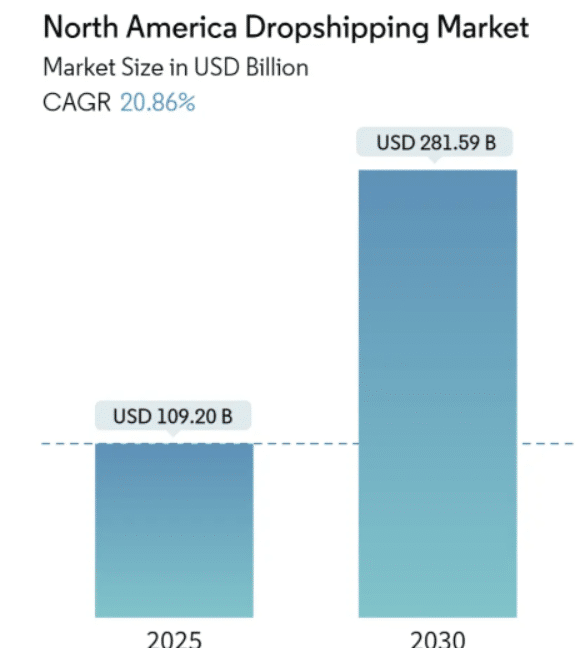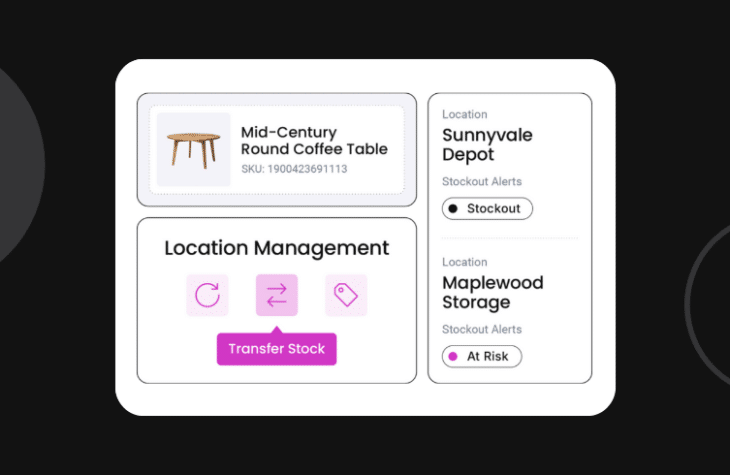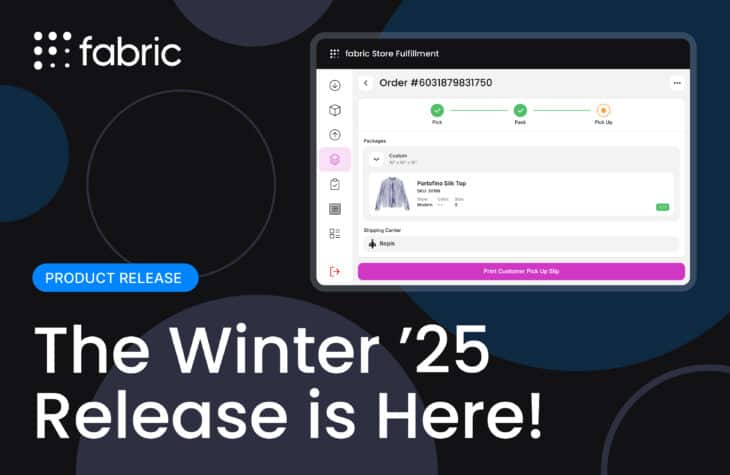The Modern Retailer’s Guide to the Dropshipping Business Model

updated April 21, 2025
Once considered a launchpad for side hustles and solo ventures, dropshipping has evolved into a powerful retail fulfillment method major brands use to scale product offerings—without adding warehouse space, overhead, or inventory risk.
So, what is dropshipping exactly?
It’s a low-risk business model that allows e-commerce retailers to sell products online without holding inventory. Instead, a third-party supplier handles storage, shipping products, and delivery once the customer places an order. This model lets you focus on sales and strategy while vendors handle the logistics.
The North American dropshipping market is projected to hit $109.2 billion in 2025, expected to surpass $281 billion by 2030, growing at a CAGR of 20.86%. That’s not just growth—it’s a reflection of the mode’s growing role in modern e-commerce business strategies.

Source: Mordor Intelligence
With brands under pressure to meet rising customer expectations and deliver broader product selections at lower costs, dropshipping offers a smart way to pre-purchase inventory when a customer places an order. It’s lean, scalable, and increasingly used to offer branded products without the logistical burden.
In this article, we’ll explore the benefits of dropshipping, key considerations for choosing your dropshipping suppliers, and the best platform features to look for if you’re considering launching or leveling up a dropshipping business.
What is dropshipping?
Unlike traditional inventory systems, where retailers stock products, dropshipping allows you to sell products without holding physical inventory.
Here’s how it operates:
- Customer places an order: A shopper visits your online retail store and selects a product.
- Order transmission: The order details are forwarded to a third-party supplier, often a manufacturer or a wholesaler.
- Direct shipment: The third-party supplier ships the product directly to the customer’s location.
In this setup, the retailer acts as the seller of record, maintaining responsibility for customer service, setting the retail price, and managing customer returns. However, handling and shipping products and inventory management are delegated to the supplier, enabling a lean and scalable operation.
Who’s using dropshipping?
Many established retailers are leveraging the dropshipping model to enhance their product offerings and meet diverse customer expectations. By integrating dropshipping services, you can expand your assortments without the burdens of traditional inventory management.
Wayfair
Wayfair, formerly known as CSN Stores, is an American home goods giant founded in 2002. After adopting the dropshipping business model, they now offer over 14 million products sourced from approximately 11,000 global suppliers.
Notably, about 95% of these products are shipped directly from suppliers to customers, allowing Wayfair to minimize inventory holding and focus on providing a vast selection to its clientele.
Lush Décor
Lush Décor is a home décor company founded by Jenny Jing Zhu in 2008. She identified a market gap for dropshipping services with major furniture retailers and established Lush Décor to provide stylish and trend-setting textiles directly to consumers.
The company minimized the need to pre-purchase inventory by leveraging dropshipping suppliers, allowing for a lean and scalable operation. Over the years, Lush Décor has experienced significant growth, generating approximately $100 million in annual revenue and partnering with major retailers such as Wayfair, Macy’s, Amazon, Target, Bed Bath & Beyond, Home Depot, and Kohl’s.
Hybrid models
Beyond pure dropshipping, some retailers like Sephora and Costco have implemented hybrid models that blend their own branded products with items fulfilled by vendors. This strategy enables business owners to maintain control over key products while expanding their offerings through dropshipping suppliers.
Such an approach balances quality assurance with the flexibility to test new markets and products, meeting evolving customer expectations effectively.
Advantages of dropshipping for established retailers
Dropshipping presents established retailers with strategic advantages, including:
- Expanded product assortment: You can offer a diverse range of products without the need for extensive warehouse space.
- Reduced inventory risk: By relying on third-party suppliers, you can minimize the financial risks associated with unsold stock.
- Cost efficiency: The dropshipping model entails minimal upfront costs, allowing you to allocate resources to other strategic initiatives.
Finding the right dropshipping partner
Identifying and partnering with the right dropshipping supplier is crucial for the success of your e-commerce business. Establishing relationships with reliable suppliers ensures efficient inventory management, maintains high product quality, and guarantees the timely handling and shipping of products to your customers.
Start with existing vendors
Begin your search by evaluating your current network of manufacturers and wholesalers. If they offer dropshipping services, you can expand your online store offering without the need to pre-purchase inventory. Leveraging these relationships can lead to seamless integration and consistent product quality.
Exploring dropshipping platforms
If you’re new to dropshipping or looking for an opportunity to diversify your product range, partner with a reliable and specialized dropshipping platform. fabric Dropship, for instance, can connect you to retailers with a vast network of dropshipping suppliers, facilitating the expansion of your product catalog while minimizing inventory risks.
Key considerations in selecting a supplier
When assessing potential suppliers, prioritize the following factors:
- Reliability: Ensure the supplier has a proven track record of fulfilling orders accurately and on time.
- Product quality: Consistent quality is vital for maintaining customer loyalty.
- Data integration: Efficient data flow between your e-commerce store and the supplier’s system is essential for real-time inventory updates and order processing.
- Shipping services: Evaluate the supplier’s proficiency in handling and shipping products to your target customer location.
Establishing a dropshipping agreement
Once you identify a suitable dropshipping partner, formalize the relationship with a comprehensive dropshipping agreement contract. This contract should detail terms regarding shipping fees, processing customer returns, and handling customer service, ensuring clear expectations and responsibilities.
Benefits of dropshipping
Embarking on the journey to start a dropshipping business offers a multitude of tangible advantages for modern entrepreneurs. Here are some compelling benefits that highlight the appeal of this low-risk business model.
Minimal initial investment
Traditional retail models often require substantial capital to purchase inventory and secure warehouse space. In contrast, dropshipping eliminates the need for upfront inventory purchases, allowing you to launch your online store with significantly reduced financial risk.
Scalable product offerings
Without the constraints of physical inventory, you can effortlessly expand your product catalog. This flexibility enables rapid adaptation to evolving customer expectations and market trends, ensuring a competitive edge in the dynamic e-commerce business landscape.
Reduced overhead expenses
By sidestepping costs associated with warehouse space, storage, and inventory management, dropshipping allows you to allocate resources more efficiently. This lean approach enhances the potential for a healthier profit margin and sustainable growth.
Operational flexibility
Managing an e-commerce store through dropshipping offers unparalleled flexibility. You can operate your business virtually anywhere via an internet connection, facilitating a work-life balance that aligns with personal preferences and goals.
Diverse product range
Access to a broad network of reliable suppliers can empower you to offer diverse products. This variety attracts a broader customer base and fosters customer loyalty by consistently meeting varied consumer needs.
Reduced shipping responsibilities
In the dropshipping model, your suppliers handle the shipment of the products directly to your customers. This arrangement alleviates your burden of managing shipping costs and logistics, streamlining operations, and enhancing efficiency.
Risk mitigation in inventory management
Since products are purchased only after a customer orders, the risk of overstocking or unsold inventory is minimized. This aspect is particularly beneficial for testing new products or markets without committing significant resources.
Dropshipping vs. third-party marketplaces
When exploring strategies to expand product offerings without the burdens of inventory management, two models are often considered: dropshipping and third-party marketplaces.
Each approach offers distinct advantages and challenges, particularly concerning control over branding, pricing, and customer experience.
Dropshipping
In the dropshipping model, you act as the seller of record, listing products on your online store without holding physical stock. Upon a customer’s purchase, you forward the order to a third-party supplier, who then handles order fulfillment by shipping products directly to the customer. This retail fulfillment method allows you to sell products without investing in inventory, offering a low-risk business model for entrepreneurs seeking efficiency.
Benefits of dropshipping model
One of the primary advantages of dropshipping is that you get to control various aspects of the business:
- Branding and customer experience: As the seller of record, you can maintain control over branding, ensuring a consistent customer experience. The customer receives products under your brand, fostering customer loyalty.
- Pricing and profit margins: You get to set the retail price, which allows you to determine your profit margin. This control enables strategic pricing to meet customer expectations while managing shipping costs and other expenses—especially when buying from suppliers at a competitive wholesale price.
- Customer service and returns: You get control over handling customer orders, processing customer returns, and overall customer service. While this ensures a direct relationship with your customers, it also means managing the complexities of handling and shipping products and addressing issues related to product quality.
Dropshipping drawbacks
While dropshipping offers significant advantages, it’s essential to acknowledge its potential challenges:
- Lower profit margins: The ease of entry into dropshipping leads to high competition, often resulting in lower profit margins. To maintain profitability, you must strategically manage pricing and costs.
- Quality control: Since third-party suppliers manage product quality and fulfillment, you may face challenges ensuring consistent quality and timely delivery, which can impact customer loyalty.
- Inventory management: Relying on suppliers for stock availability can lead to issues with inventory management, such as stockouts or delays, which can affect customer expectations. For some retailers, it may be worth exploring dropshipping alternatives like hybrid fulfillment models or direct warehousing when seeking greater control.
Third-party marketplaces
In contrast, third-party marketplaces are platforms where multiple sellers list their products. In this model, the individual sellers are typically the sellers of record, responsible for their listings, pricing, and fulfillment. The marketplace operator provides the platform and may offer dropshipping services but does not control individual seller operations.
Benefits of the marketplace model
The marketplace model offers a different set of dynamics:
- Limited control: You have limited control over branding and customer experiences, as these are managed by the sellers individually. This can lead to inconsistencies and challenges in maintaining a cohesive brand image.
- Pricing: As an individual seller, you can set your own prices, which can result in competitive pricing but may also lead to price wars and reduced profit margins.
- Customer service: Customer service responsibilities are typically divided between the marketplace operator and the individual sellers, potentially complicating handling and shipping products and processing customer returns.
Marketplace drawbacks
While the marketplace offers broad reach and convenience, it also comes with notable trade-offs:
- Loss of brand identity: When selling through third-party platforms, you often lose the ability to showcase your own branded products uniquely. With multiple sellers offering similar items, it’s easy to get lost in the noise, making it harder to build customer loyalty.
- Dependency on platform rules: You must adhere to strict policies set by the marketplace, which can include restrictions on pricing, communication, and return handling. These rules limit agility and may impede your ability to meet evolving customer expectations.
- Higher fees and commission structures: Many marketplace platforms charge transaction fees on commissions on each sale. This eats into your profit margin and makes it harder to scale sustainability, especially if you’re operating on tight margins.
- Limited access to customer data: The buyer’s data is often owned by the marketplace and not you. This lack of direct access to customer orders and behavioral data makes it difficult to refine your sales strategy or improve long-term engagement.
6 key dropshipping features to future-proof your store in 2025
Selecting the ideal dropshipping platform is crucial for the success of your e-commerce business. A robust platform not only streamlines operations but also enhances customer satisfaction and drives growth.
Here are six essential features you should consider when evaluating dropshipping services in 2025:
1. Seamless platform integrations
The platform you choose should effortlessly integrate into your e-commerce business. Such integrations ensure a cohesive operation, allowing you to manage your online store efficiently without the need for complex workarounds. Additionally, the platform should offer APIs for custom integrations, providing flexibility as your business evolves.
2. Frictionless vendor onboarding
The ability to quickly and securely connect with reliable suppliers is vital. Look for platforms that support multiple onboarding protocols, including APIs, Electronic Data Interchange (EDI), Secure File Transfer Protocol (SFTP), XML, CSV, and web portals. This versatility ensures you can establish partnerships with multiple suppliers swiftly, expanding your product range without unnecessary delays.
3. Centralized vendor management
Maintaining strong relationships with dropshipping suppliers requires effective management tools. A comprehensive platform automates compliance monitoring, ensuring all dropshipping agreement contracts are adhered to. The features should also include performance tracking, compliance checks, and user-friendly interfaces to manage these relationships seamlessly.
4. Dynamic catalog management
Effective merchandising is key to attracting and retaining customers. Your platform should provide real-time access to product information, including inventory levels and pricing. It should facilitate the exchange of product proposals with vendors, ensure data quality, and grant you full control over your product catalog, simplifying the merchandising process and enhancing the appeal of your dropshipping store.
5. Robust merchant operations
To scale your dropshipping business effectively, a platform must offer end-to-end visibility of the order lifecycle. This includes real-time order tracking, support for custom packing slips, management of order change requests, and seamless communication with vendors to ensure timely fulfillment. Such features are essential for maintaining high customer loyalty and meeting customer expectations.
6. Insightful analytics and reporting
Data-driven decision-making is critical in today’s competitive market. Your platform should provide actionable insights into business growth, product performance, vendor efficiency, and financial metrics. Access to comprehensive analytics enables you to refine your sales strategy, optimize operations, and identify expansion opportunities.
Future-proof your retail strategy with smarter dropshipping
The path to profitable growth no longer relies solely on stockpiling inventory or managing complex logistics in-house. Some leading retailers have proved that dropshipping work isn’t just for side hustlers or startups—it’s a strategic lever for scalable, omnichannel success.
If you’re wondering how dropshipping works at a mid-market level, the answer lies in finding a model that blends flexibility, speed, and control—especially when scaling a modern e-commerce store.
These days, retailers looking to expand their product offerings without overextending their operations are increasingly turning to solutions that allow them to connect with suppliers, automate processes, and meet rising customer expectations—all while maintaining brand integrity and improving the customer experience.
As the global dropshipping market continues to accelerate, fabric’s advanced Dropship platform is purpose-built to get you up to speed and keep you one step ahead. Our platform empowers you to launch and grow your online store with real-time vendor connections, end-to-end visibility, and seamless integrations into existing systems—no heavy lifting required.
From merchandising through fulfillment, we support a smart, more scalable approach to dropshipping that reduces risk while driving revenue.
Talk to our team and explore how smarter dropshipping can unlock the growth of your brand and business.
Whether testing new categories, meeting demand spikes, or scaling your assortment strategy, your chosen tools can make all the difference. With fabric, you can build a future-ready and steady retail operation.

Digital content editorial team @ fabric





